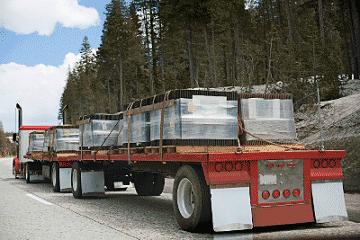- Home
- Loss Control
- Loss Control Insights
- Trailer Safety 101: Safely Hauling Loads and Equipment
When it comes to safely transporting your equipment, shortcuts are not an option. Saving a few minutes could cost you thousands in the event of an accident. Laws that regulate cargo securement vary from state to state, but here are some standard guidelines to help you keep equipment and supplies where they belong.
Know Your Numbers
Towing more than the vehicle is rated for is dangerous. The load rating of your trailer should be adequate for the weight and dimensions of the equipment you're moving. Always verify your vehicle's maximum towing capacity by checking the manufacturer weight ratings for both the vehicle and trailer. These are often found inside the driver's door while trailer ratings can be found on the trailer identification plate. Equipment information can be found in the owner's manual or by running equipment over a certified scale. In most states, loads over 80,000 lbs. require special permits.
Here are a few terms to know:
Gross Vehicle Weight Rating (GVWR)
The max loaded weight of the vehicle (or trailer). The weight includes passengers, cargo and the vehicle itself.Gross Combined Weight Rating (GCWR)
The max weight of the vehicle and trailer together. It includes any cargo or load placed in the vehicle and trailer.Curb Weight
The total weight of the vehicle not including passengers, cargo or non-factory items.Tongue Weight (TW)
The downward force exerted on the back of a tow vehicle by a trailer. Tongue weight is affected by the position of cargo in a trailer. Improper weight distribution that leads to exceeding the tongue weight will cause loss of vehicle control.To calculate the towing capacity, start with the GCWR and subtract the curb weight, passenger weight and cargo weight. Exceeding the GCWR may cause serious damage to the vehicle, making it unsafe to operate.
Place The Load
When driving up ramps, always keep the heaviest end of the equipment uphill. If transporting in the bed of a truck, place the load as far forward as possible with the heaviest part of the load at the bottom. If on a trailer, aim for the middle of the trailer and evenly distribute your equipment out from there. Lower all work tools and accessories and engage the parking brake.
Plan Your Tie-Downs
Generally, your tie-downs must have a combined strength (or aggregate working load limit) of at least 50% of your load. If your tie-downs aren't labeled with their working load limit, you can find it online.
The length of your load and its position may also affect the minimum number of tie-downs. Choose securement points that are part of the equipment's frame. Avoid sharp areas or pieces that are plastic or rubber. If you're unsure, the equipment's manual may list appropriate securement points. If your equipment has a detachable accessory, it should also be secured to the trailer.
Secure The Load
Start by using blocks and braces to secure your equipment, then tie-downs to supplement the blocking and bracing. Make sure you check your straps and chains before use, looking for cuts or other damage that might compromise their strength. If using binders to secure your load, avoid using a cheater bar to tighten the chain. You may end up overtightening, which can exceed the working load limit while also weakening the chain and attachments. Don't forget to secure the binder to keep it from opening and be careful when removing chains and straps as they can be under a lot of pressure.
Proper Pulling
Loading your trailer isn’t the only concern. Drivers pulling trailers need to understand how pulling a trailer may impact driving a vehicle. It all starts with stopping distance. The added weight of a trailer and cargo significantly increases stopping distance. The distance required to stop a vehicle depends on speed, weight and other factors like energy, heat and friction. Braking power required to stop a vehicle depends on its weight and the “square” of its speed. For example, when weight and speed are both doubled, stopping power required increases eight times to stop in the same distance.

Find More Online
- How to Tie Down Equipment on Trailers
- Securing the Load: A Guide to Safe and Legal Transport of Cargo and Equipment
- Chaining Machinery to a Trailer (VIDEO)
- Loading, Transporting & Unloading Heavy Equipment (VIDEO)
- Tech Sheet: Cargo Securement
- FMCSA: General Cargo Securement Requirements
Get in touch
Need help? We’re here for you! Whether you have questions or need personalized assistance, your local office is ready to support you.
Loss Control Insights
Stay informed with the latest news and receive actionable safety tips, all carefully curated by our team of experts.
